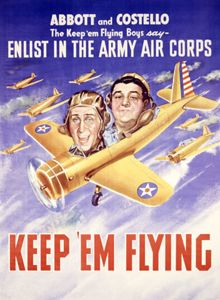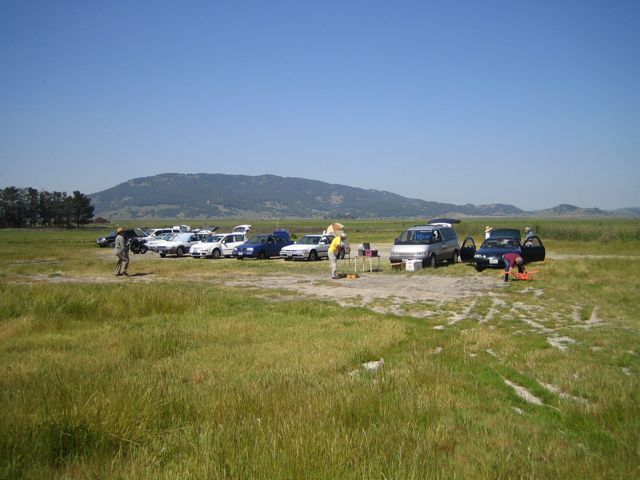The monthly indoor meeting yesterday was well attended, with several visitors including a fellow from the Netherlands. In this video, watch him learn how to launch a small model. Also see Ed's Pacific Ace and Unlimited ROG, and the Mass Launch.
4/28/08
4/25/08
1923 Poncelet light plane

By George Benson
This is a 25-inch span, rubber-powered model from a well worn Hurst Bower plan sent by a "pen pal" from Australia. On paper, it should be a good flyer: slim body, no struts, minimal landing gear, stabilizer on top of the body for easy D.T. hinging, good wing area, and easy wing attachment by rubber bands onto dowels. I like unusual planes which are little modeled, so set to and built it.
 The pilot is experienced, having been mounted on other models, now scrapped. The dummy foam engine was from a Flying Flea I had built and scrapped long ago.
The pilot is experienced, having been mounted on other models, now scrapped. The dummy foam engine was from a Flying Flea I had built and scrapped long ago. Wheels are of blue foam with aluminum tube spindles; the pilot's headrest also blue foam. Covering is silver tissue (Esaki?) and red, as the plan indicates red and silver on the original plane.
I had some trouble building the wing to my satisfaction, as in my desire for light weight plus the depth of the ribs (slightly over 5/8" at the root rib and just over 1/2" at the tip rib). I tried cracked rib construction, abandoned that approach, made conventional ribs with lightening holes which were too fragile, and reverted to conventional ribs of light 1/20" wood.
 Initially, I had made aluminum templates of the root and tip rib, stacked the wood between and shaped them, but the result was not satisfactory due to the pronounced angle (top and bottom) as I sanded them.
Initially, I had made aluminum templates of the root and tip rib, stacked the wood between and shaped them, but the result was not satisfactory due to the pronounced angle (top and bottom) as I sanded them.At this point I thought through . . . again . . . how to best shape the ribs of six sizes and approached it the following way:
1. From the plan, make a photocopy of the rib profile shown, usually the root rib. Then tint it with black felt tip pen to show up well in subsequent photocopying procedure.
2. Carefully measure the length of each rib, off the plan. Write the lengths down, measuring in millimeters as it facilitates the next step.
3. Proportion each rib size, a simple step using a calculator. For example, assume the root rib is 114 mm (about 4-1/2") and the next rib is 109 mm (about 4-5/16"). Divide the second rib length by the root rib length -- i.e. 109/114 = 0.956 which is 95% of the length of the big root rib.
4. With a photocopier capable of enlarging and shrinking, set it to 95%, put in your photocopy of the root rib, print it at this 95% ratio and there you are with rib #2 profile.
5. Repeat for each rib after measuring the length on the plan.
6. Take two stacked pieces of balsa, attach the paper template with glue stick, hold the two rib blanks together with pins, cut around with a sharp blade, notch for the spars with a small rat tail file, and do likewise for each size rib.

Testing so far is a little troublesome. I started with a 4 bladed wood prop, but then changed to an 8" plastic as I felt it is better to use a proven prop and tinker later with a more scale prop. The thrust line is high, and the rubber fouls the top former and support for the pilot, so I may try a new nose block with a little lower bearing position, to lower the rubber and also to try to overcome another difficulty -- that the angle of the rear rubber peg tends to pull the prop shaft hook downwards, giving upthrust.
To minimize this I added a "wedge" at the bottom rear of the nose block, to "hook" over the front former bottom (a little inconvenient when inserting the nose block but it does improve the situation). By the way, I do realize the lowered thrust line is "non scale," but as I fly for fun, not a contester, that is immaterial to me!! Power so far is 2 loops x 17" of 3/16" rubber. Power was low after some tests but this was traced to a loose plug lead on the foam dummy motor!!!
The original full size plane was constructed by a Belgian company, Poncelet, (probably a family name and a manufacturer of wooden full size propellers) to enter in the British light plane contest in 1923 at Lympne. I have not found any photos of the plane and the registration letters on the plan seem to be incorrect, being a British registration allocated to a Tiger Moth. I guesstimated registration letters for that period, but am unsure whether the early Belgium national registration was O or OO. A small point to me, not being competitive and enjoying building and the pleasure derived from the flying field with friends, a calm, warm day and the sun shining through the tissue as a model floats aloft.

4/20/08
The Flight of the Celtic
I made this video of George launching my Celtic at our indoor session last month with my Canon Power Shot SD300 Digital ELPH in movie mode. Feeling creative, I did some editing with Apple iLife 08 software and published my video to the web. I've never done anything like this before. The result is not bad, especially considering the camera fits in my pocket.
Dave W.
4/10/08
SAM 27 CONTEST
We are fortunate to be able to use the SAM 27 club field for our once monthly outdoor sessions on the second Sunday of each month. Those of us that are members of SAM 27 can enter this contest.
4/1/08
Truly, a Canard

By George Benson
This peanut sized 13-inch model of the Pfalz Canard Torpedo Carrier is an extremely rare model, as documentation is scarce and only one prototype was built towards the end of WW1 by Pfalz Flugzeugwerke G.m.b.H., at their works in Speyer-on-Rhine.
The objective of the design was to have a torpedo carrying plane to attack British ships by flying low over the English Channel and spotting ships. The canard carried armour plating in the center section of the wing as the pilot was vulnerable to attack from a higher flying fighter. The lonely rear gunner was intended to deter attack further.
Only limited flight testing was carried out; the plane was grossly overloaded with a torpedo carried below the fuselage, which changed the C of G when launched in limited tests. In addition, the engine was an experimental early Junkers, based on a rather primitive "aero oil engine using spark ignition." The combination of excess weight, changing C of G, and inadequate power, plus the impending end of WW1, understandably caused the project to be abandoned.
Incidentally, attentive readers will be interested to note the pronunciation of "PFALZ" is identical to "FALSE."

Some further information relating to this peanut model is that it is indeed "FALSE" as there was no such an aircraft, merely from my active mind when I scrapped a peanut Drziewicki pusher canard from plans by Benno G. Sabel, but the fuselage was in reasonably good shape so eventually I thought about rebuilding it or in some way utilizing the body. This musing led to the development of this "PFALZ."
I reversed the body, making it a tractor, glued two North Pacific 4-inch props together, sketched out all flying surfaces with straight wood, and as the project was underway decided to give it an old time appeal, hence the scalloped trailing edge and pseudo-Germanic decorations. The canard is attached by rubber bands which minimizes breakage if impacting the wall in the gym, which was a problem with the Drzewiecki with a delicate canard attached rigidly to the body.
 The peanut flies remarkably well, flies stably, circles well, being fairly heavy at 18.1 grams, with a 13-inch loop of rubber about 5/32". Wing chord is 3-1/4" and canard is 9" x 2-1/2". Motor peg is at the very end of the fuselage. Airfoil section is "looks about right."
The peanut flies remarkably well, flies stably, circles well, being fairly heavy at 18.1 grams, with a 13-inch loop of rubber about 5/32". Wing chord is 3-1/4" and canard is 9" x 2-1/2". Motor peg is at the very end of the fuselage. Airfoil section is "looks about right."
I have flown it outdoors and it is remarkably stable but then I have to re-trim it and change the rubber for indoors, so I have decided to fly only in the gym and consider building a larger one (about 30-inch) for outdoor fun flying.

Some further information relating to this peanut model is that it is indeed "FALSE" as there was no such an aircraft, merely from my active mind when I scrapped a peanut Drziewicki pusher canard from plans by Benno G. Sabel, but the fuselage was in reasonably good shape so eventually I thought about rebuilding it or in some way utilizing the body. This musing led to the development of this "PFALZ."
I reversed the body, making it a tractor, glued two North Pacific 4-inch props together, sketched out all flying surfaces with straight wood, and as the project was underway decided to give it an old time appeal, hence the scalloped trailing edge and pseudo-Germanic decorations. The canard is attached by rubber bands which minimizes breakage if impacting the wall in the gym, which was a problem with the Drzewiecki with a delicate canard attached rigidly to the body.
 The peanut flies remarkably well, flies stably, circles well, being fairly heavy at 18.1 grams, with a 13-inch loop of rubber about 5/32". Wing chord is 3-1/4" and canard is 9" x 2-1/2". Motor peg is at the very end of the fuselage. Airfoil section is "looks about right."
The peanut flies remarkably well, flies stably, circles well, being fairly heavy at 18.1 grams, with a 13-inch loop of rubber about 5/32". Wing chord is 3-1/4" and canard is 9" x 2-1/2". Motor peg is at the very end of the fuselage. Airfoil section is "looks about right."I have flown it outdoors and it is remarkably stable but then I have to re-trim it and change the rubber for indoors, so I have decided to fly only in the gym and consider building a larger one (about 30-inch) for outdoor fun flying.
Subscribe to:
Posts (Atom)








